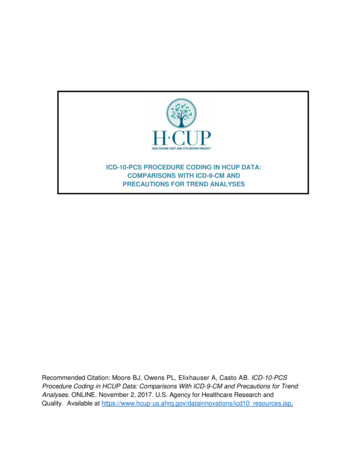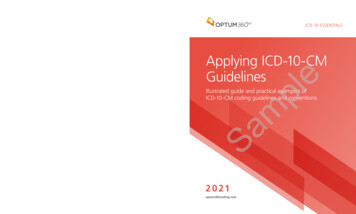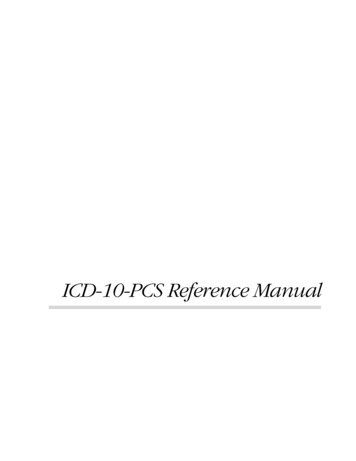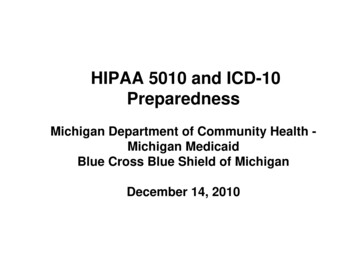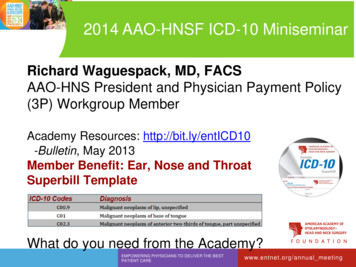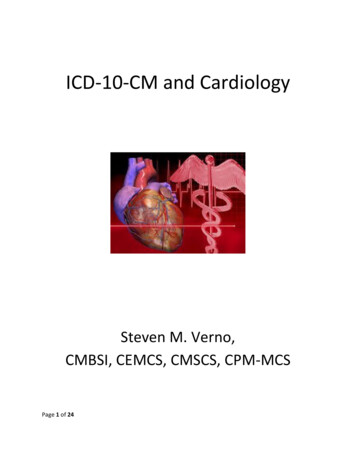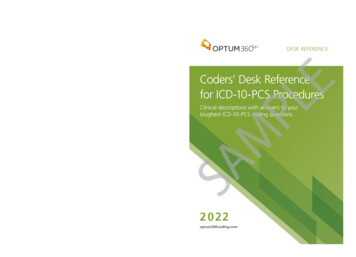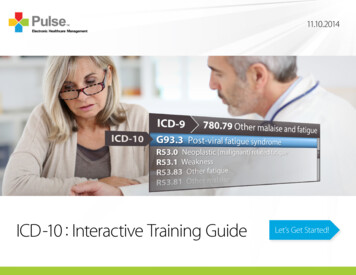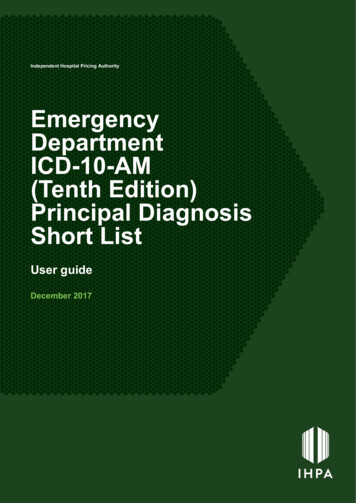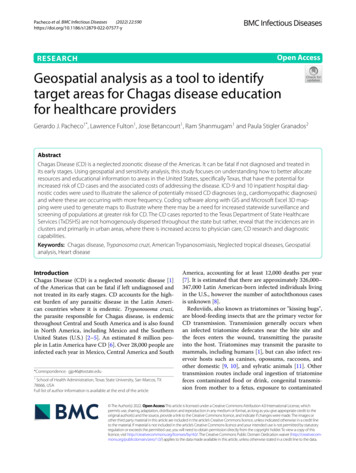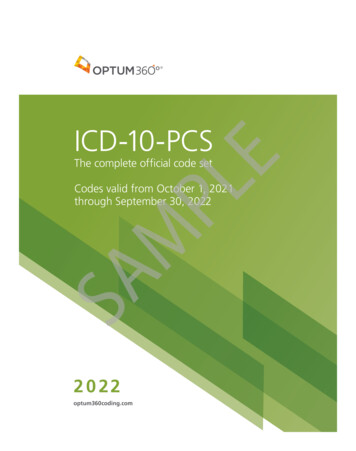
Transcription
PLEICD-10-PCSThe complete official code setSAMCodes valid from October 1, 2021through September 30, 20222 0 22optum360coding.com
ContentsWhat’s New for 2022 .iiiIntroduction .1PLENumber of Codes in ICD-10-PCS .1ICD-10-PCS Manual .1Medical and Surgical Section (0) .4Obstetrics Section (1) .7Placement Section (2) .8Administration Section (3) .9Measurement and Monitoring Section (4) .9Extracorporeal or Systemic Assistance andPerformance Section (5) .10Extracorporeal or Systemic Therapies Section (6) .10Osteopathic Section (7) .11Other Procedures Section (8) .11Chiropractic Section (9) .12Imaging Section (B) .12Nuclear Medicine Section (C) .13Radiation Therapy Section (D) .13Physical Rehabilitation and Diagnostic Audiology Section (F) .14Mental Health Section (G) .15Substance Abuse Treatment Section (H) .15New Technology Section (X) .16Mouth and Throat . 351Gastrointestinal System . 369Hepatobiliary System and Pancreas . 397Endocrine System . 411Skin and Breast . 421Subcutaneous Tissue and Fascia . 439Muscles . 459Tendons . 481Bursae and Ligaments . 495Head and Facial Bones . 517Upper Bones . 537Lower Bones . 557Upper Joints . 575Lower Joints . 595Urinary System . 617Female Reproductive System . 633Male Reproductive System . 653Anatomical Regions, General . 669Anatomical Regions, Upper Extremities . 681Anatomical Regions, Lower Extremities . 691Obstetrics . 701Placement . 705Administration . 711Measurement and Monitoring . 723Extracorporeal or Systemic Assistance and Performance . 727Extracorporeal or Systemic Therapies . 729Osteopathic . 731Other Procedures . 733Chiropractic . 735Imaging . 737Nuclear Medicine . 767Radiation Therapy . 777Physical Rehabilitation and Diagnostic Audiology . 795Mental Health . 807Substance Abuse Treatment . 809New Technology . 811ICD-10-PCS Index and Tabular Format .19Index .19Code Tables .19ICD-10-PCS Additional Features .21MUse of Official Sources .21Table Notations .21Appendixes .22ICD-10-PCS Official Guidelines for Codingand Reporting 2022 .25SAConventions .25Medical and Surgical Section Guidelines (section 0) .26Obstetric Section Guidelines (section 1) .30Radiation Therapy Section Guidelines (section D) .30New Technology Section Guidelines (section X) .31Index .33ICD-10-PCS Tables .131Central Nervous System and Cranial Nerves . 131Peripheral Nervous System . 151Heart and Great Vessels . 169Upper Arteries . 191Lower Arteries . 215Upper Veins . 239Lower Veins . 259Lymphatic and Hemic Systems . 279Eye . 297Ear, Nose, Sinus . 315Respiratory System . 335ICD-10-PCS 2022Appendixes . 817Appendix A: Components of the Medical andSurgical Approach Definitions .817Appendix B: Root Operation Definitions . 821Appendix C: Comparison of Medical and SurgicalRoot Operations . 827Appendix D: Body Part Key . 829Appendix E: Body Part Definitions . 845Appendix F: Device Classification . 857Appendix G: Device Key and Aggregation Table . 859Appendix H: Device Definitions . 869Appendix I: Substance Key/Substance Definitions . 875Appendix J: Sections B–H Character Definitions . 879Appendix K: Hospital Acquired Conditions . 889Appendix L: Procedure Combination Tables . 909Appendix M: Coding Exercises and Answers . 931i
IntroductionICD-10-PCS: The Complete Official Code Set is your definitive codingresource for procedure coding in acute inpatient hospitals. In additionto the official ICD-10-PCS Coding System Files, revised and distributedby the Centers for Medicare and Medicaid Services (CMS), Optum360’scoding experts have incorporated Medicare-related coding edits andproprietary features, such as coding tools and appendixes, into acomprehensive and easy-to-use reference.This manual provides the most current information that was availableat the time of publication. For updates to official source documents thatmay have occurred after this manual was published, please refer to thefollowing:CMS International Classification of Disease, 10th Revision,Procedural Coding System 021-icd-10-pcs CMS Inpatient Prospective Payment System Proposed tient-pps/fy-2021-ipps-proposed-rule-home-pageIn ICD-10-PCS, the term procedure refers to the complete specificationof the seven characters.Number of Codes in ICD-10-PCSThe table structure of ICD-10-PCS permits the specification of a largenumber of codes on a single page. At the time of this publication, thereare 78,103 codes in the 2021 ICD-10-PCS.PLE character of the procedure code always specifies the section. The secondthrough seventh characters have the same meaning within eachsection, but may mean different things in other sections. In all sections,the third character specifies the general type of procedure performed(e.g., Resection, Transfusion, Fluoroscopy), while the other charactersgive additional information such as the body part and approach. CMS Inpatient Prospective Payment System Proposed Rule,FY 2021 - Proposed, version 38, MS-DRG Grouper software,Definitions Manual files and Medicare Code Editor (MCE) ations-andSoftware American Hospital Association (AHA) Coding ifierSAICD-10-PCS has a seven-character alphanumeric code structure. Eachcharacter contains up to 34 possible values. Each value represents aspecific option for the general character definition. The 10 digits 0–9and the 24 letters A–H, J–N, and P–Z may be used in each character. Theletters O and I are not used so as to avoid confusion with the digits 0and 1. An ICD-10-PCS code is the result of a process rather than as asingle fixed set of digits or alphabetic characters. The process consistsof combining semi-independent values from among a selection ofvalues, according to the rules governing the construction of codes.1234567A code is derived by choosing a specific value for each of the sevencharacters. Based on details about the procedure performed, values foreach character specifying the section, body system, root operation,body part, approach, device, and qualifier are assigned. Because thedefinition of each character is also a function of its physical position inthe code, the same letter or number placed in a different position in thecode has a different meaning.The seven characters that make up a complete code have specificmeanings that vary for each of the 17 sections of the manual.Procedures are then divided into sections that identify the general typeof procedure (e.g., Medical and Surgical, Obstetrics, Imaging). The firstICD-10-PCS 2022IndexCodes may be found in the index based on the general type ofprocedure (e.g., resection, transfusion, fluoroscopy), or a morecommonly used term (e.g., appendectomy). For example, the code forpercutaneous intraluminal dilation of the coronary arteries with anintraluminal device can be found in the Index under Dilation, or asynonym of Dilation (e.g., angioplasty). The Index then specifies the firstthree or four values of the code or directs the user to see another term.Example:ICD-10-PCS Code StructureCharacters:ICD-10-PCS ManualDilationArteryCoronaryOne Artery 0270Based on the first three values of the code provided in the Index, thecorresponding table can be located. In the example above, the firstthree values indicate table 027 is to be referenced for code completion.The tables and characters are arranged first by number and then byletter for each character (tables for 00-, 01-, 02-, etc., are followed bythose for 0B-, 0C-, 0D-, etc., followed by 0B1, 0B2, etc., followed by 0BB,0BC, 0BD, etc.).Note: The Tables section must be used to construct a complete andvalid code by specifying the last three or four values.TablesThe tables in ICD-10-PCS provide the valid combination of charactervalues needed to build a unique procedure code. Each table is precededby the first three characters of the code, along with their descriptions. Inthe Medical and Surgical section, for example, the first three characterscontain the name of the section (character 1), the body system(character 2), and the root operation performed (character 3).Listed underneath the first three characters is a table comprising fourcolumns and one or more rows. The four columns in the table specifythe last four characters needed to complete the ICD-10-PCS code.Depending on the section, the labels for each column may be different.In the Medical and Surgical section, they are labeled body part(character 4), approach (character 5), device (character 6), and qualifier(character 7). Each row in the table specifies the valid combination ofvalues for characters 4 through 7.1
ICD-10-PCS Official Guidelines for Coding andReporting 2022Narrative changes appear in bold text.The Centers for Medicare and Medicaid Services (CMS) and the NationalCenter for Health Statistics (NCHS), two departments within the U.S.Federal Government’s Department of Health and Human Services(DHHS) provide the following guidelines for coding and reporting usingthe International Classification of Diseases, 10th Revision, ProcedureCoding System (ICD-10-PCS). These guidelines should be used as acompanion document to the official version of the ICD-10-PCS aspublished on the CMS website. The ICD-10-PCS is a procedureclassification published by the United States for classifying proceduresperformed in hospital inpatient health care settings.Example:Where the fifth axis of classification specifies the approach, sevendifferent approach values are currently used to specify the approach.A3. The valid values for an axis of classification can be added to asneeded.Example:If a significantly distinct type of device is used in a new procedure, anew device value can be added to the system.PLEThese guidelines have been approved by the four organizations thatmake up the Cooperating Parties for the ICD-10-PCS: the AmericanHospital Association (AHA), the American Health InformationManagement Association (AHIMA), CMS, and NCHS.A2. One of 34 possible values can be assigned to each axis ofclassification in the seven-character code: they are the numbers 0through 9 and the alphabet (except I and O because they are easilyconfused with the numbers 1 and 0). The number of unique values usedin an axis of classification differs as needed.SAMThese guidelines are a set of rules that have been developed toaccompany and complement the official conventions and instructionsprovided within the ICD-10-PCS itself. They are intended to providedirection that is applicable in most circumstances. However, there maybe unique circumstances where exceptions are applied. Theinstructions and conventions of the classification take precedence overguidelines. These guidelines are based on the coding and sequencinginstructions in the Tables, Index and Definitions of ICD-10-PCS, butprovide additional instruction. Adherence to these guidelines whenassigning ICD-10-PCS procedure codes is required under the HealthInsurance Portability and Accountability Act (HIPAA). The procedurecodes have been adopted under HIPAA for hospital inpatient healthcaresettings. A joint effort between the healthcare provider and the coder isessential to achieve complete and accurate documentation, codeassignment, and reporting of diagnoses and procedures. Theseguidelines have been developed to assist both the healthcare providerand the coder in identifying those procedures that are to be reported.The importance of consistent, complete documentation in the medicalrecord cannot be overemphasized. Without such documentationaccurate coding cannot be achieved.ConventionsA1. ICD-10-PCS codes are composed of seven characters. Eachcharacter is an axis of classification that specifies information about theprocedure performed. Within a defined code range, a characterspecifies the same type of information in that axis of classification.Example:The fifth axis of classification specifies the approach in sections 0through 4 and 7 through 9 of the system.Section:Body System:Operation:0JHA5. As the system is expanded to become increasingly detailed, overtime more values will depend on preceding values for their meaning.Example:In the Lower Joints body system, the device value 3 in the rootoperation Insertion specifies Infusion Device and the device value 3in the root operation Replacement specifies Ceramic SyntheticSubstitute.A6. The purpose of the alphabetic index is to locate the appropriatetable that contains all information necessary to construct a procedurecode. The PCS Tables should always be consulted to find the mostappropriate valid code.A7. It is not required to consult the index first before proceeding to thetables to complete the code. A valid code may be chosen directly fromthe tables.A8. All seven characters must be specified to be a valid code. If thedocumentation is incomplete for coding purposes, the physician shouldbe queried for the necessary information.A9. Within a PCS table, valid codes include all combinations of choicesin characters 4 through 7 contained in the same row of the table. In theexample below, 0JHT3VZ is a valid code, and 0JHW3VZ is not a validcode.ApproachSubcutaneous Tissue and Fascia, Head and Neck 0 OpenSubcutaneous Tissue and Fascia, Upper Extremity 3 PercutaneousSubcutaneous Tissue and Fascia, Lower ExtremitySubcutaneous Tissue and Fascia, Trunk0 Open3 PercutaneousICD-10-PCS 2022Example:The meaning of a body part value in the Medical and Surgicalsection is always dependent on the body system value. The bodypart value 0 in the Central Nervous body system specifies Brain andthe body part value 0 in the Peripheral Nervous body systemspecifies Cervical Plexus.Medical and SurgicalSubcutaneous Tissue and FasciaInsertion Putting in a nonbiological appliance that monitors, assists, performs, or prevents a physiological function but does notphysically take the place of a body partBody PartSVWTA4. As with words in their context, the meaning of any single value is acombination of its axis of classification and any preceding values onwhich it may be dependent.Device13Y13VYRadioactive ElementInfusion DeviceOther DeviceRadioactive ElementInfusion DeviceInfusion PumpOther DeviceQualifierZ No QualifierZ No Qualifier25
Central Nervous System and Cranial Nerves 001–00XCharacter MeaningsThis Character Meaning table is provided as a guide to assist the user in the identification of character members that may be found in this section of codetables. It SHOULD NOT be used to build a PCS code.Operation–Character 3Body Part–Character 4Approach–Character 5Device–Character 6Qualifier–Character BrainCerebral MeningesDura MaterEpidural Space, IntracranialSubdural Space,Intracranial034X0123401234NasopharynxMastoid SinusAtriumBlood VesselPleural ubarachnoid Space,IntracranialCerebral VentricleCerebral Hemisphere67Peritoneal CavityUrinary JKLMNPQRSTUVWXYBasal GangliaThalamusHypothalamusPonsCerebellumMedulla OblongataCranial NerveOlfactory NerveOptic NerveOculomotor NerveTrochlear NerveTrigeminal NerveAbducens NerveFacial NerveAcoustic NerveGlossopharyngeal NerveVagus NerveAccessory NerveHypoglossal NerveSpinal MeningesSpinal CanalSpinal CordCervical Spinal CordThoracic Spinal CordLumbar Spinal Cord89ABFGHJKLMNPQRSXZBone MarrowFallopian TubeSubgaleal SpaceCerebral CisternsOlfactory NerveOptic NerveOculomotor NerveTrochlear NerveTrigeminal NerveAbducens NerveFacial NerveAcoustic NerveGlossopharyngeal NerveVagus NerveAccessory NerveHypoglossal NerveDiagnosticNo Qualifier7JKDrainage DeviceRadioactive ElementMonitoring DeviceInfusion DeviceRadioactive Element,Cesium-131 CollagenImplantAutologous TissueSubstituteSynthetic SubstituteNonautologous TissueSubstituteNeurostimulator LeadOther DeviceNo DeviceMYZSAMPLEOpenPercutaneousPercutaneous EndoscopicExternalICD-10-PCS 2022131Central Nervous System and Cranial NervesICD-10-PCS Tables
04V04V–04VMedical and SurgicalLower ArteriesRestrictionDefinition: Partially closing an orifice or the lumen of a tubular body part04VExplanation: The orifice can be a natural orifice or an artificially created orificeBody PartCharacter 4ApproachCharacter 50 Abdominal AortaInferior phrenic arteryLumbar arteryMedian sacral arteryMiddle suprarenal arteryOvarian arteryTesticular artery0 OpenC Extraluminal Device3 PercutaneousE Intraluminal Device,Branched or Fenestrated,4 Percutaneous EndoscopicOne or Two ArteriesF Intraluminal Device,Branched or Fenestrated,Three or More ArteriesZ No Device0 OpenD Intraluminal Device3 Percutaneous4 Percutaneous EndoscopicZ No QualifierJ TemporaryZ No QualifierC Extraluminal DeviceD Intraluminal DeviceZ No DeviceZ No QualifierC Extraluminal DeviceD Intraluminal DeviceE Intraluminal Device,Branched or Fenestrated,One or Two ArteriesZ No DeviceZ No QualifierPLE0 OpenH External Iliac Artery, RightDeep circumflex iliac artery3 PercutaneousInferior epigastric artery4 Percutaneous EndoscopicJ External Iliac Artery, LeftSee H External Iliac Artery, RightK Femoral Artery, RightCircumflex iliac arteryDeep femoral arteryDescending genicular arteryExternal pudendal arterySuperficial epigastric arteryL Femoral Artery, LeftSee K Femoral Artery, RightM Popliteal Artery, RightInferior genicular arteryMiddle genicular arterySuperior genicular arterySural arteryTibioperoneal trunkN Popliteal Artery, LeftSee M Popliteal Artery, RightP Anterior Tibial Artery, RightAnterior lateral malleolararteryAnterior medial malleolararteryAnterior tibial recurrent arteryDorsalis pedis arteryPosterior tibial recurrent arteryQ Anterior Tibial Artery, LeftSee P Anterior Tibial Artery,RightR Posterior Tibial Artery, RightS Posterior Tibial Artery, LeftT Peroneal Artery, RightFibular arteryU Peroneal Artery, LeftSee T Peroneal Artery, RightV Foot Artery, RightArcuate arteryDorsal metatarsal arteryLateral plantar arteryLateral tarsal arteryMedial plantar arteryW Foot Artery, LeftSee V Foot Artery, RightY Lower ArteryUmbilical artery0 Open3 Percutaneous4 Percutaneous EndoscopicQualifierCharacter 7SAM0 Abdominal AortaInferior phrenic arteryLumbar arteryMedian sacral arteryMiddle suprarenal arteryOvarian arteryTesticular artery1 Celiac ArteryCeliac trunk2 Gastric ArteryLeft gastric arteryRight gastric artery3 Hepatic ArteryCommon hepatic arteryGastroduodenal arteryHepatic artery proper4 Splenic ArteryLeft gastroepiploic arteryPancreatic arteryShort gastric artery5 Superior Mesenteric ArteryIleal arteryIleocolic arteryInferior pancreaticoduodenalarteryJejunal artery6 Colic Artery, Right7 Colic Artery, Left8 Colic Artery, Middle9 Renal Artery, RightInferior suprarenal arteryRenal segmental arteryA Renal Artery, LeftSee 9 Renal Artery, RightB Inferior Mesenteric ArterySigmoid arterySuperior rectal arteryE Internal Iliac Artery, RightDeferential arteryHypogastric arteryIliolumbar arteryInferior gluteal arteryInferior vesical arteryInternal pudendal arteryLateral sacral arteryMiddle rectal arteryObturator arterySuperior gluteal arteryUmbilical arteryUterine arteryVaginal arteryF Internal Iliac Artery, LeftSee E Internal Iliac Artery, RightDeviceCharacter 6Lower ArteriesLower ArteriesICD-10-PCS 2022C Common Iliac Artery, RightD Common Iliac Artery, Left04V–04V3 Limited Coverage 4 Noncovered ? Combination Member HAC associated procedure Combination Only DRG Non-OR Non-ORICD-10-PCS 2022New/Revised in GREEN237
Upper Veins 051–05WCharacter MeaningsThis Character Meaning table is provided as a guide to assist the user in the identification of character members that may be found in this section of codetables. It SHOULD NOT be used to build a PCS code.Operation–Character 3Body Part–Character 4Approach–Character 5Device–Character 6Qualifier–Character ction013456789AAzygos VeinHemiazygos VeinInnominate Vein, RightInnominate Vein, LeftSubclavian Vein, RightSubclavian Vein, LeftAxillary Vein, RightAxillary Vein, LeftBrachial Vein, RightBrachial Vein, ionRevisionBCDFGHLMNPQRSTVYBasilic Vein, RightBasilic Vein, LeftCephalic Vein, RightCephalic Vein, LeftHand Vein, RightHand Vein, LeftIntracranial VeinInternal Jugular Vein, RightInternal Jugular Vein, LeftExternal Jugular Vein, RightExternal Jugular Vein, LeftVertebral Vein, RightVertebral Vein, LeftFace Vein, RightFace Vein, LeftUpper VeinMYZDrainage DeviceMonitoring DeviceInfusion DeviceAutologous Tissue SubstituteAutologous Venous TissueAutologous Arterial TissueExtraluminal DeviceIntraluminal DeviceSynthetic SubstituteNonautologous TissueSubstituteNeurostimulator LeadOther DeviceNo DeviceUltrasonicDrug-Coated BalloonDiagnosticUpper VeinNo QualifierMPLEOpenPercutaneousPercutaneous EndoscopicExternalAHA Coding Clinic for table 0512020, 1Q, 282017, 3Q, 15Free flap microvascular breast reconstructionBypass of innominate vein to atrial appendageAHA Coding Clinic for table 059Catheter placement for treatment of congestive heart failureSA2018, 3Q, 7AHA Coding Clinic for table 05B2020, 1Q, 242016, 2Q, 12Resection of vascular malformation, likely cavernomaResection of malignant neoplasm of infratemporal fossaAHA Coding Clinic for table 05H2016, 4Q, 97-98Phrenic neurostimulatorAHA Coding Clinic for table 05P2016, 4Q, 97-98Phrenic neurostimulatorAHA Coding Clinic for table 05Q2017, 3Q, 15Bypass of innominate vein to atrial appendageAHA Coding Clinic for table 05S2013, 4Q, 125Stage II cephalic vein transposition (superficialization) of arteriovenous fistulaAHA Coding Clinic for table 05W2016, 4Q, 97-98ICD-10-PCS 2022Phrenic neurostimulator239Upper VeinsUpper VeinsICD-10-PCS 2022
Respiratory System 0B1–0BYCharacter MeaningsThis Character Meaning table is provided as a guide to assist the user in the identification of character members that may be found in this section of codetables. It SHOULD NOT be used to build a PCS code.Operation–Character 3Body Part–Character 4Approach–Character 5Device–Character 6Qualifier–Character nchial TreeTracheaCarinaMain Bronchus, Right03470123Drainage DeviceRadioactive ElementMonitoring DeviceInfusion rainage487EsophagusExcision5CAutologous TissueSubstituteExtraluminal Device6BXDiagnosticCExtirpation6DIntraluminal DeviceZNo QualifierDExtraction7Upper Lobe Bronchus,RightMiddle Lobe Bronchus,RightLower Lobe Bronchus,RightMain Bronchus, LeftEFHFragmentationInsertion89Upper Lobe Bronchus, LeftLingula BronchusFGJLInspectionOcclusionBCLower Lobe Bronchus, LeftUpper Lung Lobe, RightJKMReattachmentDMiddle Lung Lobe, plantationFGHJKLMNPQTLower Lung Lobe, RightUpper Lung Lobe, LeftLung LingulaLower Lung Lobe, LeftLung, RightLung, LeftLungs, BilateralPleura, RightPleura, LeftPleuraDiaphragmYZIntraluminal Device,Endotracheal AirwayTracheostomy DeviceIntraluminal Device,Endobronchial ValveSynthetic SubstituteNonautologous TissueSubstituteDiaphragmatic PacemakerLeadOther DeviceNo DeviceMPLEXOpenPercutaneousPercutaneous EndoscopicVia Natural or ArtificialOpeningVia Natural or ArtificialOpening EndoscopicExternalAHA Coding Clinic for table 0B5Photodynamic therapy for treatment of malignant mesotheliomaThoracoscopic ta
In ICD-10-PCS, the term procedure refers to the complete specification of the seven characters. Number of Codes in ICD-10-PCS The table structure of ICD-10-PCS permits the specification of a large number of codes on a single page. At the time of this publication, there are 78,103 codes in the 2021 ICD-10-PCS. ICD-10-PCS Manual Index
